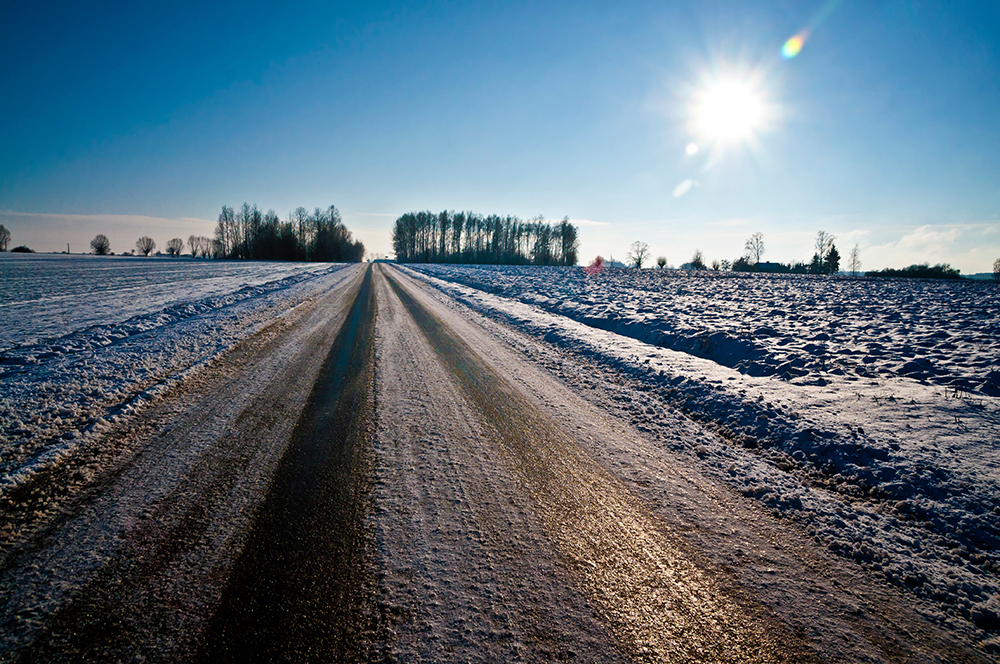More than 70% of our nation’s roadways are located in snowy regions, according to the Federal Highway Administration (FHA).
Any type of moisture on the road, whether it’s rain, snow, or ice, can decrease friction between vehicle tires and the roadway, limiting maneuverability and increasing braking times and distances. If you travel in or near Philadelphia or anywhere that experiences snow or winter-time precipitation, it’s important to understand the dangers of driving on black ice.
What Is Black Ice?
Also known as clear ice, black ice is a smooth, thin layer of transparent ice on the surface of a roadway.
This type of ice can form quickly and is almost impossible to spot—even if you’re looking for it.
It’s important to point out that black ice isn’t actually black. Since it’s clear, it takes on the appearance and color of whatever is beneath it. And, in the case of asphalt, that color is usually black.
Clear Ice – Understanding the Causes and Risks
There are a number of circumstances under which black ice can form. These can include when:
- Snow or ice melts and then refreezes.
- Freezing rain hits pavements or roadways that are already cooled to below-freezing temperatures.
- Freezing fog makes contact with freezing pavements or roadways.
- Packed snow becomes more and more compressed, and partially thaws before freezing again.
Clear or black ice is most likely to form on roadways and sidewalks. Bridges and overpasses tend to ice over first, as currents of air flowing underneath cause the pavement to cool down faster. There may also be patches in shaded areas (such as underneath trees and door awnings) and near downspouts.
It’s no wonder that ice, snow, and slush contribute to nearly 25% of all weather-related vehicle accidents.
So, what makes driving in these conditions so dangerous?
Due to its translucent or clear nature, it’s nearly impossible to spot—even with clear visibility. If you can’t see a hazard on the road, you can’t take proper safety measures to protect yourself, your vehicle, and your passengers.
Black ice is also very dangerous because it tends to be slicker than other types of icy patches that form on roadways. Steering and braking will not work normally, so it’s easy to lose control of your vehicle in the blink of an eye. Both single- and multi-vehicle accidents can happen when a driver spins out or loses control behind the wheel.
4 Safety Tips for Driving on Black Ice
We want you and everyone you love to be as safe as possible when traveling this winter season, so we’ve compiled our top four tips for safely driving on black ice.
- Stay home. If possible, limit your driving time when you know the weather is poor or driving conditions are less than ideal.
- Remain calm. We know it’s scary to encounter a difficult driving situation, but staying calm will help you come out of this experience as safely as possible.
- Don’t slam on the brakes. Braking is largely ineffective on icy roads. Instead, take your foot completely off the accelerator to start slowing down.
- Keep your steering wheel steady. Don’t make any big or sharp turns. Keep your steering wheel steady in the same position it’s already in. If you have to steer, do so gradually.
The typical patch of black ice is, on average, 20 feet or less in length. If you hit an icy patch and lose control of your vehicle, the goal is to safely glide until you hit solid pavement and your tires regain traction.
By remaining calm and being mindful of your actions, you can reduce your risk of being involved in a weather-related accident.
However, a lower risk doesn’t mean that there’s no risk at all.
Fault for a Weather-Related Accident
When it comes to recovering compensation for accident-related injuries, financial losses, and emotional damages, determining liability is exceptionally important. Your right to financial recovery rests on your ability to correctly identify what factors caused your accident, and who played a role in those factors.
Crashes involving a texting or speeding driver tend to be fairly straightforward. Liability for an accident that involves weather conditions is sometimes less clear.
So, can you hold a driver who lost control on a patch of ice and then hit you liable for your damages?
The short answer is: yes. Bad weather is not an excuse to cause an accident and then avoid taking responsibility for it.
Negligent drivers and their auto insurers are often resistant to taking responsibility for motor vehicle collisions when weather-related factors are also at play. If you’ve been hit and injured, you deserve a fair chance at financial recovery. The most effective way to preserve your right to compensation is to work closely with an experienced attorney.
Finding Financial Security After a Black Ice Accident
The dangers of driving on black ice are clear and present for those of us who live in areas with winter weather.
If you’ve been hurt, we want to help. You can schedule a completely free, no-obligation case evaluation by calling our office or filling out our convenient online form. An experienced team of Philadelphia car accident attorneys is standing by to help!









